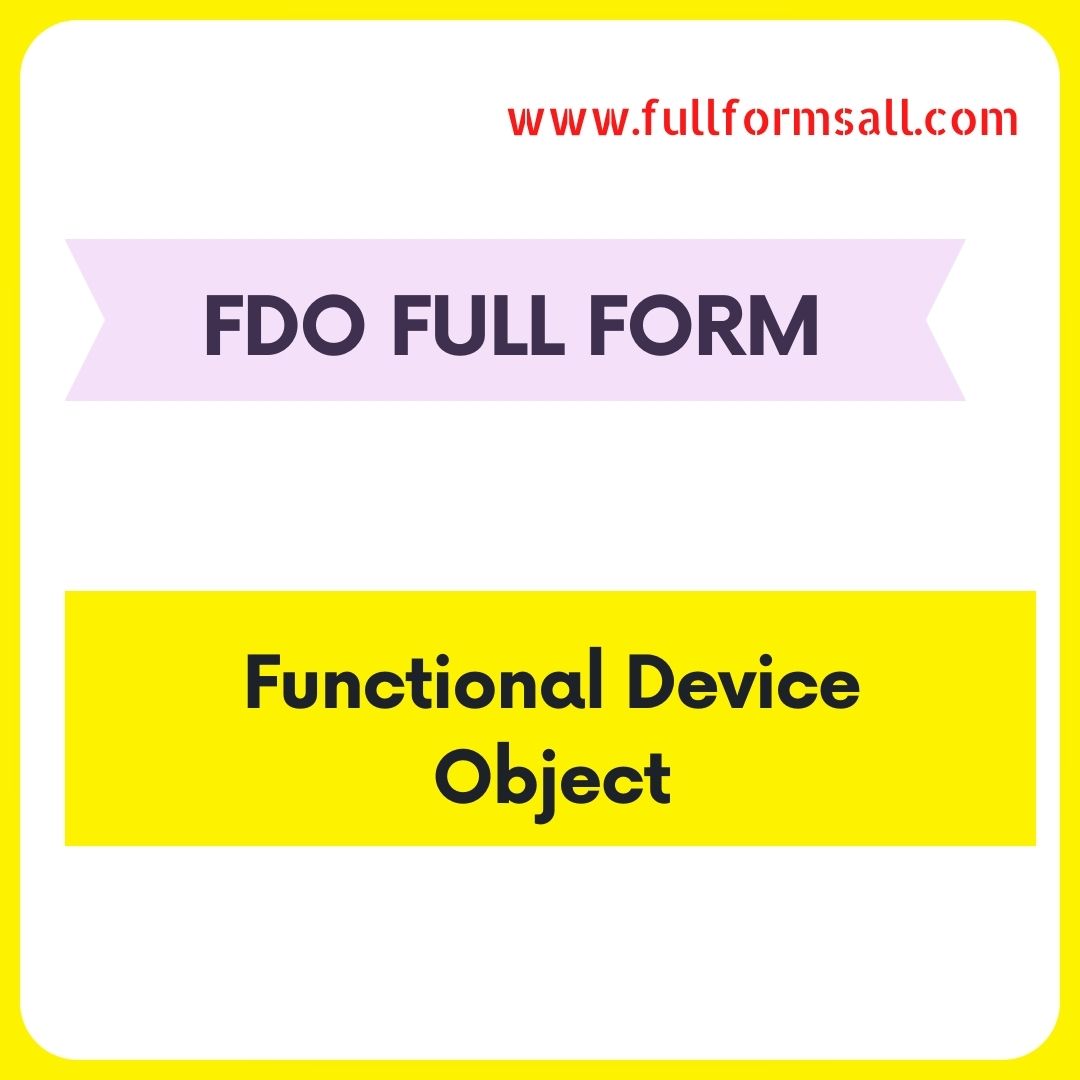In this article you get to know about FDO full from and other different abbreviations of FDO in various fields. FDO full form refers to Functional Device Object.
A Functional Device Object is a software component used in the Windows operating system to represent a functional device. In the context of Windows driver development, a functional device refers to a logical device that provides a particular function or service. The FDO acts as an intermediary between the physical hardware device and the device driver software. It is responsible for managing the device’s resources, handling I/O requests, and providing an interface for communication with the device driver.
The FDO is typically implemented as a kernel-mode driver and is created when the corresponding physical device is detected and enumerated by the Plug and Play system. The FDO driver registers itself with the Plug and Play Manager, allowing the operating system to communicate with the device through the FDO.

Tasks performed by the FDO include:
Handling PnP (Plug and Play) and power management events: The FDO receives notifications from the operating system regarding device insertion, removal, power state changes, and other relevant events. It manages the device’s PnP and power states accordingly.
Managing I/O requests: The FDO handles I/O requests from the device stack, which includes processing read and write requests, issuing commands to the hardware, and returning the results to the calling driver or application.
Resource management: The FDO is responsible for managing the device’s resources, such as memory, I/O ports, interrupts, and DMA channels. It allocates and deallocates these resources as necessary.
Providing an interface for device driver communication: The FDO exposes an interface that allows device drivers or applications to interact with the device. This interface includes IOCTL (input/output control) codes and other methods for configuring and controlling the device.
Details about Functional Device Objects:
Device Stack: In the Windows driver model, devices are organized in a hierarchical stack called the device stack. The FDO represents the top-level device in this stack. Below the FDO, there may be one or more lower-level devices called Physical Device Objects, which represent the actual physical instances of the device.
Bus Drivers: FDOs are commonly associated with bus drivers. A bus driver is responsible for managing a specific type of bus, such as USB, PCI, or ACPI. When a new device is detected on the bus, the bus driver creates an FDO to represent it and establishes communication with the device.
PnP and Power Management: FDOs handle various Plug and Play (PnP) events, such as device insertion, removal, and hardware configuration changes. They interact with the Plug and Play Manager to negotiate device resources and ensure smooth integration of the device into the system. FDOs also manage power management features, allowing the device to enter different power states and respond to power-related events.
Device Initialization: FDOs are responsible for initializing the associated hardware device during system startup or when it is added to the system. This includes tasks like configuring the device, setting up interrupts, enabling I/O operations, and allocating necessary resources.
Device I/O Processing: When an application or device driver issues an I/O request to the device, the request is typically forwarded to the FDO. The FDO processes the request, which may involve translating it into commands understood by the hardware, performing data transfers, and handling any necessary protocol conversions. The FDO then returns the result of the operation back to the requesting driver or application.
Driver Interface: FDOs expose an interface to device drivers and applications, allowing them to control and interact with the device. This interface often includes IOCTL codes, which are specific command codes used to issue control requests and retrieve device-specific information.
Device Removal and Cleanup: When a device is being removed from the system, the FDO performs necessary cleanup operations, releases allocated resources, and prepares the device for removal. This includes ensuring that any pending I/O operations are completed or canceled appropriately.
Bus-specific Functionality: FDOs may provide additional functionality specific to the type of bus they are associated with. For example, a USB FDO may handle USB-specific features such as enumeration, device configuration, and handling USB class-specific requests.
FDO plays a crucial role in the Windows driver stack, acting as the main point of interaction between the operating system, device drivers, and the underlying hardware. It abstracts the hardware complexities and provides a standardized interface for device control and data transfer.
Different abbreviations of FDO in various fields are as follows
| Term | Abbreviation | Category |
| FDO | Food And Distribution Officer | Business |
| FDO | Food Development Officer | Business |
| FDO | Finance And Development Officer | Business |
| FDO | Flight Deck Officer | Military and Defence |
| FDO | Flexible Deterrent Option | Military and Defence |
| FDO | Fire Direction Officer | Military and Defence |
| FDO | Foreign Disclosure Officer | Military and Defence |
| FDO | Fundamental Deterioration Overview | Military and Defence |
| FDO | Fighter Director Officer | Other |
| FDO | Future Doom Overlord | Other |
| FDO | Food Distribution Office | Other |
| FDO | Flight Data Operations Division | Other |
| FDO | Final Determination And Order | Other |
| FDO | Functional Device Object | Other |
| FDO | Flight Dynamics Officer | Other |
| FDO | Flight Directors Office | Other |
| FDO | Form Display Operation | Other |
| FDO | Foodgrain Distribution Office | Other |
CONCLUSION:
Dear reader in this article you get to know about FDO full from and FDO term used in various other fields, If you have any query regarding this article kindly comment below.